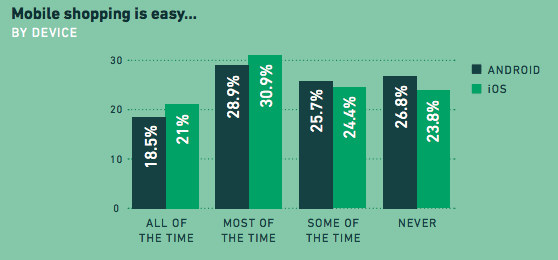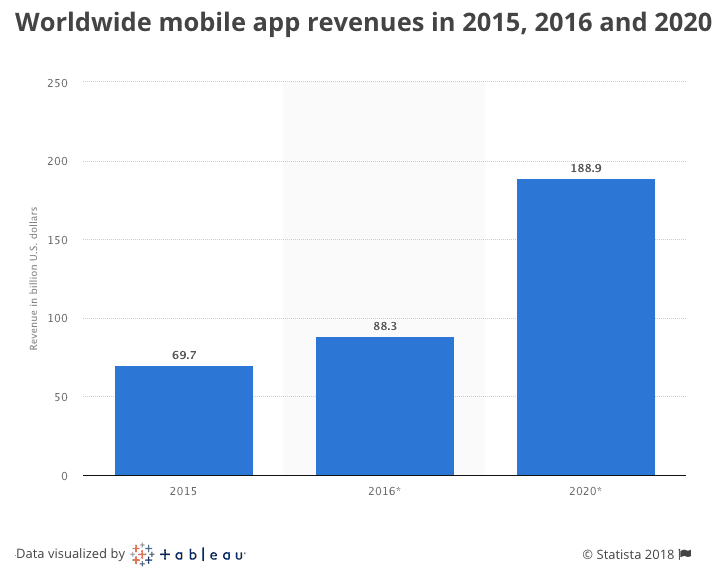There are billions of dollars in the mobile app industry.
So it’s safe to say that there is definitely plenty of money to be made. This is encouraging news if you currently have a mobile app or if you’re thinking about turning your app idea into a reality.
How much money will you make?
Well, the answer to this question greatly depends on a lot of different variables. Your app may not make a billion dollars, but you can access a piece of that pie and still turn a hefty profit.
In order to do so, the first step is mobile app development.
For those of you who already have one, that’s great; you’ve got a head start. Just because your existing app isn’t making money hand over fist, it doesn’t mean that it’s too late to make adjustments.
One of the factors that impacts your revenue is whether you develop for the Google Play Store or Apple App Store.
It also depends on your app monetization models. There are three main ways that mobile apps can make money.
- subscriptions
- in-app purchases
- advertisements
Which app monetization model is right for you?
You’ll also have to take into consideration that mobile apps aren’t just for phones anymore. There is an emerging market for additional devices.
In this guide, I’ll cover all of these topics in greater detail. You’ll also learn more about how free apps make money, how paid apps make money, how game apps make money, and more. This will give you a much better understanding of how to make money from your own app or with an app development idea.
Studies show that more iOS users find mobile shopping easier than Android users.

In recent years, nearly 47% of iOS users made a purchase from a smartphone. Only about 38% of Android users did the same.
So you’ve got to decide what you want. Would you prefer to have a smaller percentage of a larger population to buy something? Or is it better to have a larger portion of a smaller population?
I’ll talk about this concept in greater detail a bit later on when we discuss the different types of app revenue streams.
But for those of you who haven’t started development yet, one of the first things you need to do is figure out your target market. Don’t make assumptions.
You’ll need to conduct actual research to figure out who will be interested in using your app.
This may seem like a daunting task if you’ve never done it before. But trust me, it’s worth the extra effort. It will save you headaches down the road and make sure that you don’t launch on the wrong platform.
As a result, releasing your app on the right platform will help ensure that you’re making as much money as possible.
Another factor that falls into this category is how your app works. Your mobile application needs to perform well, regardless of which platform you’re building for. For example, let’s say your app is live on Google Play. Users won’t be able to make in-app purchases if it’s buggy and always crashing.
For those of you who already have a live app, you may want to take a look at its performance to see if there are any issues that could be hindering your profits.
If users have a bad experience with your app, they are more likely to abandon it.
ake a look at the future projections for mobile app revenue worldwide in the coming years.

The total projected revenue in 2020 is more than double the global revenue from 2016. So the mobile app industry is showing no signs of slowing down at any point in the near future.
This means that the industry leaders will continue to make more money, but new apps also have a chance to get a piece of the action as well.
App Monetization Strategies for 2024_ Diversify and Engage
There's no one-size-fits-all approach to app monetization, but with the right strategies, you can turn your mobile app into a revenue-generating machine. Here's a rundown of some popular and effective options for 2024, with a focus on diversification and user engagement:
In-App Monetization
In-app advertising: Still a classic, consider interactive and native formats like rewarded video ads, playable ads, or in-feed ads for a non-intrusive experience.
In-app purchases: Go beyond consumables; offer cosmetic enhancements, subscriptions within features, or tiered access to unlock advanced functionalities.
Freemium model: Refine your free/premium balance. Offer enough value in the free version to entice upgrades, and make premium features truly compelling.
Subscription Models
Tiered subscriptions: Cater to different user needs with varying price points and feature sets.
Value-added subscriptions: Bundle exclusive content, early access, or community perks with the subscription for increased perceived value.
Trial periods and freemium tiers: Attract potential subscribers with limited trial periods or freemium access to specific features within a subscription model.
Alternative Strategies
Donations: Appeal to your user base's goodwill by offering the option to donate directly to support development and maintenance.
Affiliate marketing: Partner with relevant brands and promote their products within your app, earning commissions on purchases made through your referral.
Data monetization: With user consent, anonymize and aggregate app usage data for market research or targeted advertising, ensuring transparency and ethical practices.
Key Strategies for 2024
Personalization: Tailor in-app offers and recommendations based on user behavior and preferences for a more engaging experience.
Subscription fatigue: Offer flexible subscription options, discounts, and loyalty rewards to combat churn and retain subscribers.
Microtransactions: Introduce smaller, more affordable in-app purchases to cater to users hesitant about larger spendings.
Focus on engagement: Prioritize user retention and positive app experiences. Engaged users are more likely to convert into paying customers through any of these strategies.
Remember
Testing and analysis: Experiment with different approaches and track results to see what resonates best with your audience.
Transparency and ethical practices: Be upfront about monetization methods and avoid manipulative tactics. Building trust with your users is crucial for long-term success.
Constant adaptation: The app landscape is dynamic. Stay informed about new trends and adjust your strategies accordingly.
Future of development
Today you’ve got to think outside of the box when it comes to mobile app development. Apps are no longer just for smartphones and tablets. Again, look at the app market.
Smart TVs are on the rise in the United States.

Directly from their TVs, users can access apps such as
- YouTube
- Hulu
- Netflix
- HBO Now
- Watch ESPN
- Amazon Video
There are also apps available for video game consoles like PlayStation4, Xbox One, and Wii U. All of these devices have app stores built into the system.
There is even a growing market for novelty apps and productivity apps. These are less complex, which means it’s easier to build and maintain.
As a result, profit margins can be much higher.
For more information contact : support@mindnotix.com
Mindnotix Software Development Company


 AI-Taxi App
AI-Taxi App AI-Food App
AI-Food App AI-Property Mgmt App
AI-Property Mgmt App AI-CRM
AI-CRM AI-Fantasy App
AI-Fantasy App
 Web Development
Web Development App Development
App Development Business & Startup
Business & Startup Hire Developer
Hire Developer
 Digital Marketing
Digital Marketing Lead-generation
Lead-generation Creative Agency
Creative Agency Branding Agency
Branding Agency Augmented Reality
Augmented Reality Virtual Reality
Virtual Reality Internet of Things
Internet of Things Artificial Intelligence
Artificial Intelligence Blockchain
Blockchain Chatbot
Chatbot



